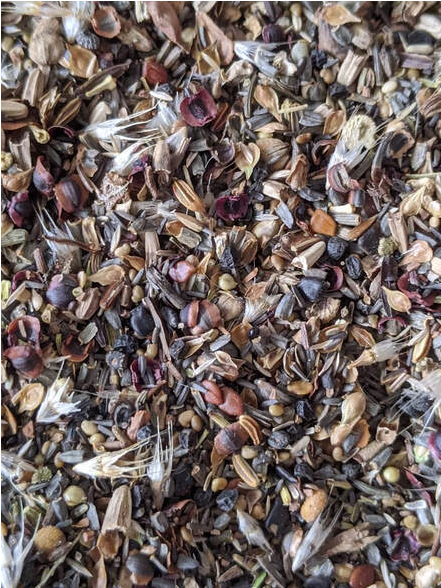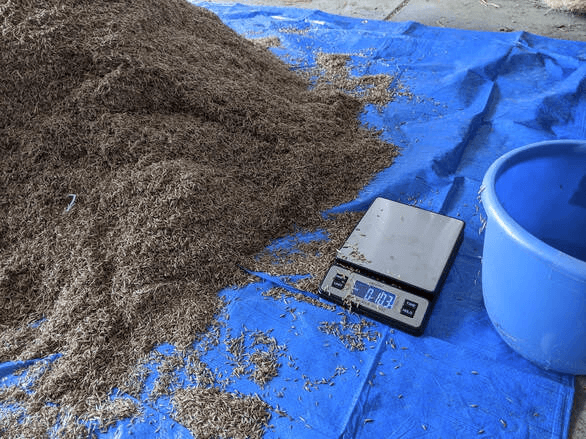
On Home Affordability, Poverty, and Unlawning America
I don’t know who that Michael Green financial analyst guy is who looked at one county in NJ to state
With cooler weather comes seeding season. After a few hard freezes and before the new year is the best time to sow, giving seeds ample time to be stratified and break dormancy for spring germination. Following is a brief guide on creating a custom seed mix and sowing it by hand.
Generally speaking, a prairie-style seeding has the following ratios:
50 seeds / ft
50% grass (25 seeds / ft)
50% forbs (25 seeds / ft)
Let’s break the percentages down further on our 50/50 mix into functional groups that fill various ecological niches:35% warm season grass
15% cool season grass and / or sedge
10% legumes
10% annuals
30% perennials
Why are we using these percentages? While some site and / or aesthetic goals will require different percentages, this is generally a solid breakdown to hit as many goals as possible at one time. The warm season grasses will do the bulk of the matrix work, while the cool season grasses and sedge will help with weed control and site stabilization in the shoulder seasons when they grow most actively. Legumes add nitrogen to the soil, while annuals provide first year weed competition, erosion control, and color. Perennial flowers will do the bulk of the aesthetic show, and within their 30% is a mix of early successional species as well as those that take longer to establish but that are also longer lived. Now, let’s take a look at a sample list and seed weights; do note that this is a very basic list using illustrative species and is not necessarily meant for application.

THE SEEDS
Since you’ll be buying seed by the ounce, you’ll need to know how many seeds are in an ounce; that information (along with more details on germination codes) can be found most easily online at Prairie Moon Nursery for each species you’re using.
Calculating seeds per foot
Here’s a sample calculation for Sideoats grama (Bouteloua curtipendula), assuming it alone would comprise the warm-season grass category:
50 seeds per foot x 0.35 (35%) = 17 seeds per foot
17 seeds per foot x 2,000 square feet = 34,000 seeds
34,000 seeds / 6,600 seeds per ounce = 5.15oz
For a 2,000’ area at 50 seeds per foot on bare soil, our seed list might look like this:
35% warm season grass (17 seeds/ft)
Bouteloua curtipendula
6,600 seeds per ounce, 17 seeds per foot, 34,000 seeds = 5.15oz
15% cool season grass / sedge (8/ft)
Carex brevior
29,000 seeds per ounce, 4 seeds per foot, 8,000 seeds = 0.28oz
Carex rosea
53,000 per oz, 4 seeds per foot, 8,000 seeds = 0.15oz
10% legumes (6/ft)
Amorpha canascens
16,000 seeds per ounce, 3 seeds per foot, 6,000 seeds = 0.375oz
Dalea purpurea
15,000 seeds per ounce, 3 seeds per foot, 6,000 seeds = 0.375oz
10% annuals (6/ft)
Coreopsis tinctoria
87,500 seed per ounce, 3 seeds per foot, 6,000 seeds = 0.069oz
Chamaecrista fasciculata
2,700 seeds per ounce, 3 seeds per foot, 6,000 seeds = 2.2oz
30% perennials (15/ft)
Zizia aurea
11,000 per oz, 2 per foot, 4,000 = 0.36oz
Echinacea pallida
5,200 per oz, 2 per foot, 4,000 = 0.77oz
Asclepias tuberosa
4,300 per oz, 2 per foot, 4,000 seeds = 0.93oz
Pycnanthemum tenuifolium
378,000 per oz, 2 per foot, 4,000 seeds = 0.01oz
Rudbeckia hirta (pioneer / early successional)
92,000 per oz, 2 per foot, 4,000 seeds = 0.043oz
Liatris aspera
16,000, 2 per foot, 4,000 seeds = 0.25oz
Ratibida pinnata (pioneer / early successional)
30,000, 2 per foot, 4,000 seeds = 0.13oz
Symphyotrichum laeve
55,000, 2 per foot, 4,000 seeds = 0.07oz
Total weight of pure live seed — 11.162oz

There’s probably not a magic bullet on creating a custom seed mix. Generally, I’m trying to give you a middle-of-the road baseline which you can tweak. Warm season grass seed may do best with a late spring seeding — but it also might not be practical, which is why doubling its rate in a dormant seeding may be a good idea. Seeds of any plant type can be eaten or washed away or just never do anything, so I subscribe to the more-is-better-if-you-can-afford-it scenario. When you buy seed you should see a tag that shows PLS (pure live seed); this percentage is calculated by taking into consideration seed purity, germination rate, and seed dormancy. You can use PLS to increase or decrease rates of each species based on the expected germination rate. See, it gets quite complex, and if it’s too much for you right now just know that the most important aspect in a seeding is diversity — diversity of species, niches, and ecosystem function so we create resilience. The above list could easily benefit from increased diversity in habit, succession, bloom color, bloom time, and bloom sequence, for example.
In the end, we simply want to cover the ground ASAP and we want competition ASAP; the more plants we have with a diversity of functional groups, the sooner a garden can perform ecosystem services. Several studies of prairie restorations show that the ratio of survival from seed to mature plant is generally around 5-10%, so if you want 5 plants per square foot you’ll need to sow 50 seeds per square foot.
BROADCASTING SEED
A person can do 1 acre tossing seed by hand in under a day, and most people reading this book probably won’t be sowing anywhere near this size. To get a more uniform seed distribution when hand sowing you’ll want to use a very slightly moistened or dry seed carrier, a medium that bulks up the mix. Most folks use compost, sand, sawdust, or vermiculite at a rate of 0.5 cubic feet (3.75 gallons) per 1,000 square feet. However, for small areas, you can eyeball it — one handful of seed per 4-5 handfuls of carrier. I prefer vermiculite, which isn’t heavy like sand or compost and, to my eye, provides the most even seed distribution with the carrier (you can also see where your seed has landed very easily — broadcasting on top of puffy snow that does not have a surface layer of ice on a sunny day also works well). You do not want to hand broadcast on a windy day — generally, less than 10mph is good, and 0 is best. Walking with the wind to your back is also helpful as a light breeze can help carry the seed forward as you broadcast.
Divide your seed mix + carrier in half; walking one way broadcast the first half, then walking perpendicular broadcast the second half. Be stingy as it’s better to have too much than not enough, but you won’t hit every square foot and you don’t necessarily have to. In the first growing season mow the area down to 4-6″ when weeds get 8-12″ tall. In the second season mow or trim the space at 12″ tall to continue depriving annual weeds of flowering and setting seed.

I don’t know who that Michael Green financial analyst guy is who looked at one county in NJ to state

Oh that’s a cool plant, stiff goldenrod, Oligoneuron rigidum. I wonder if that would work in my garden. Maybe it’s
